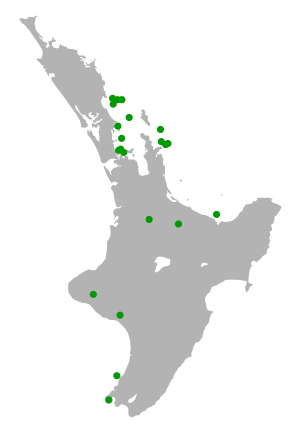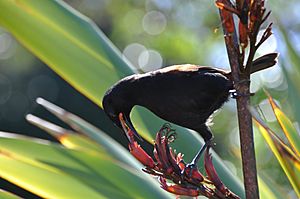North Island saddleback facts for kids
The North Island saddleback (Philesturnus rufusater) is a special forest bird found only in the North Island of New Zealand. In the Māori language, it's called the tīeke. These birds were once thought to be the same as the South Island saddleback, but now scientists know they are different species. The saddleback is currently listed as "Near Threatened," which means it needs protection, but its numbers are slowly recovering.
Quick facts for kids North Island saddleback |
|
|---|---|
 |
|
| North Island saddleback, Zealandia (wildlife sanctuary) | |
| Conservation status | |
| Scientific classification | |
| Genus: |
Philesturnus
|
| Species: |
rufusater
|
 |
|
| Islands and sanctuaries where North Island saddlebacks are present | |
| Synonyms | |
|
Philesturnus carunculatus rufusater |
|
Contents
About the North Island Saddleback
Naming and Classification
The North Island saddleback was first described by a scientist named René Lesson in 1828. He gave it the scientific name Icterus rufusater. The name rufusater comes from Latin words meaning 'reddish-brown' and 'black', which describe the bird's colors.
Later, scientists decided that saddlebacks needed their own special group, called a genus. So, the North Island saddleback was placed in the genus Philesturnus. This name combines parts of two other bird names: Philemon (friarbirds) and Sturnus (starlings).
For a long time, the North Island saddleback and the South Island saddleback were thought to be just different types of the same bird. But now, most scientists agree they are two completely separate species. The North Island saddleback's full scientific name is Philesturnus rufusater.
What They Look Like
North Island saddlebacks are mostly black. They have a special chestnut-colored patch on their back, which looks like a saddle. This is how they got their name! Their rump and tail feathers are also chestnut.
A small yellow line on the top edge of their "saddle" helps tell them apart from South Island saddlebacks. They have a black, starling-like beak. Bright orange-red flaps of skin, called wattles, hang from the base of their beak.
These birds are about 25 cm long. Males are usually a bit heavier (80 g) than females (69 g). Males also have longer beaks and bigger wattles.
Their Call
North Island saddlebacks make calls that sound like "cheet, te-te-te-te" or "ti-e-ke-ke-ke-ke". Their Māori name, tīeke, actually comes from the sound of their call!
Where They Live
North Island saddlebacks naturally live in lowland forests with broadleaf trees and evergreen coastal forests. However, because of special efforts to move them, they can now be found in other types of forests too.
Before people arrived in New Zealand, North Island saddlebacks lived all over the mainland. But sadly, cutting down forests and new animals like rats, brought by humans, caused their numbers to drop a lot. By the 1890s, they had disappeared from the mainland. The only saddlebacks left were on Hen Island, a small island off the coast of Northland.
Moving Birds to New Homes (Translocations)

To help the saddlebacks survive, the New Zealand Wildlife Service started moving them to new, safe islands in 1964. This process is called translocation. The first birds were moved to Whatapuke Island.
Since then, many more translocations have happened. North Island saddlebacks now live on several offshore islands and even some places on the mainland, like at Lake Rotorua. Some of these places include:
- Hen and Chicken Islands (Hen Island, Whatapuke Island, Lady Alice Island, Coppermine Island)
- Little Barrier Island
- Tiritiri Matangi Island
- Cuvier Island
- Red Mercury Island
- Stanley Island
- Moutohora Island (Whale Island)
- Mokoia Island, Lake Rotorua
- Kapiti Island
- Motuihe Island
- Rangitoto Island
- Motutapu Island
North Island saddlebacks were brought back to the mainland in 2002. This happened at the Karori Wildlife Sanctuary (now called Zealandia) in Wellington. This sanctuary has special fences to keep predators out. Some saddlebacks have even started to breed outside the sanctuary's protected area! Other mainland sanctuaries have also welcomed saddlebacks. In 2013, there were at least 7,000 North Island saddlebacks.
Life and Habits
Reproduction and Life Cycle
North Island saddlebacks are monogamous, which means they usually choose one partner and stay with them for life. Their breeding season can change depending on the year and where they live. However, they usually start laying eggs from August to April. Young saddlebacks, called fledglings, are often seen until March and April.
Saddlebacks build their nests mostly inside holes in trees. They can lay up to four eggs in one clutch (a group of eggs laid at one time).
What They Eat
The North Island saddleback's diet includes insects, berries, other small invertebrates, and nectar from flowers. Their strong beaks help them break open dead wood to find insects like grubs. They look for food at all heights in the forest, but they spend most of their time on the forest floor, searching through fallen leaves.
Threats to Saddlebacks
New animals brought to New Zealand, especially brown rats, were the main reason North Island saddlebacks disappeared from the mainland. Saddlebacks are easily caught by predators because they often rest and nest in low places.
For example, when saddlebacks were moved to Kapiti Island between 1981 and 1990, many of them died because of rats. The rats were not removed from the island until 1998.
Today, most North Island saddleback groups live on islands or in sanctuaries where there are no predators. These places are protected by special fences. This keeps the birds safe from animals like rats. Saddlebacks seem to get along better with kiore (Pacific rats) than with brown or black rats. This might be because they have lived with kiore for a longer time.
Now, people are working to get rid of pests around mainland sanctuaries. This will help the saddlebacks spread out and live safely outside the protected areas.
Other health concerns for saddlebacks include bird diseases like avian malaria and avian pox. These diseases have affected South Island saddlebacks. Scientists are worried that they might spread to the North Island saddlebacks in the future.
See also
 In Spanish: Tieke de Isla Norte para niños
In Spanish: Tieke de Isla Norte para niños



